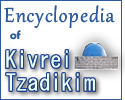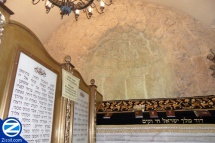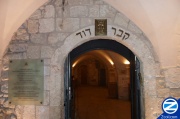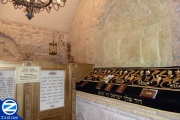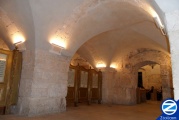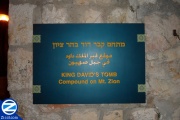Dovid HaMelech
Dovid HaMelech was the second king of Israel and founder of the Davidic royal dynasty. He passed away on Shevuas which fell out on Shabbos that year.
Contents |
[edit] Anointment
When Shmuel saw that Dovid had a reddish complexion, he thought this indicated murderous traits just like were found in Esav,[1] which would make him unfit for royalty. Hashem answered that he had beautiful eyes, which indicted that he would only kill by the ruling of the Sanhedrin, who are the eyes of the Nation[1] which have the right to use murder in holiness, as the death sentence when applicable. [2]
[edit] Warriors
King Dovid's warriors included Yoav ben Tzrua, Aveshi ben Tzrua, Adino Haetzni and Benayahu ben Yehoyada.
[edit] Serving Hashem
Since his youth, King Dovid would constantly beseech and cry out to Hashem that He should draw him close to His service. He would cry out again and again until he literally[3] became exhausted, depleted and physically faint from crying out and his throat became parched from all moisture, yet his eyes continued to yearn for Hashem[4]
[edit] Spiritual Levels
Listening to music from an evil person is very spiritually damaging, Dovid was on the level of being able to rectify even such music, thereby raising the 'Rulership of Holiness', which was one of the direct elements that caused him to become king.[5]
[edit] Teshuva
Although the incident of Bat Sheva was not considered a sin, on the level where Dovid Hamelech was holding it was considered a flaw and he did ferocious Teshuva to cleanse his soul from it, at the same time opening the gateway for future sinners to repent. For six months Dovid accepted upon himself leprosy. During this period, the Shichina separated itself from him and the members of the Sanhedrin abstained from him. For another 22 years Dovid lost his Ruach Hakodesh. Each day during these years, Dovid would fast and cry, each night eating his bread dipped in ashes. For 13 of these years he was forced to spend much time laying in bed with great suffering and each day they would replace seven pillows from under him after they became soaked in puss, blood and fluids.
He also graciously accepted the great humility of being dethroned by Avshalem, going as far as to thank Hashem for it in Tehilim Chapter 3. He also accepted the severe curse of Shimi ben Gira who himself was holding at a fearsome level. During all these years Dovid's enemies gloried thinking that Hashem had abandoned him, until he shook the entire upper universe with his awesome Teshuva. It was staggering that Dovid did such Teshuva for a minor flaw, he therefore merited the aspect of Moshiach, to become the 4th foot of the chariot, head to all those with Roach Hakodesh and Royalty was given to his descendants forever. (Taharas Hakodesh 275 Pesach Hatshuva)
[edit] Kever Dovid HaMelech
Dovid HaMelech is buried in Har Tzion, a hill southwest of Har Habais, right outside the walls of the Old City. While most people visit the established Tzion, the actual kivarim of the Kings of the House of Dovid are located in a series of large underground chambers stretching into the surrounding area. There is a tradition stating; the actual chamber containing the kever of King Dovid lies below the open field in back of the Tzion. Some Kabbalists and rabbis preferred to pray in this location instead. Kever Dovid HaMelech's location on Har Tzion was authenticated by the holy Arizal. On way of his immigration from Egypt to Safed, he stood outside the walls of the Old City near Shar Tzion and confirmed the location. This is brought down by Rabbi Moshe Chagiz rather then Rabbi Chaim Vital in Shaar Hagilgulim.
[edit] The Tzion
The room housing the Tzion lines up perfectly parallel to Har Habais. Behind the Tzion is an arched indent, causing many to believe the room served in the past as a Beit Knesset with the indent housing an Aron Kodesh. Early sources such as a student of the Ramban, the Ridbaz and Rabbi Ishtori Haparchi state; that this room housed the actual Aron Habris from the time Dovid brought it to Yerushalaim until his son King Shlomo transferred it to the newly built Beis Hamikdash forty years later. Dovid initially brought the Aron with intention of building the Beis Hamikdash. When Nasson Hanavi informed him that his son would build it instead, Dovid created the building now containing the Tzion to house it temporarily. It was built to line up with Har Habais, which would later house the Bais Hamikdash, whose location had been revealed to Dovid by Shmuel Hanavi years earlier as he fled from King Shaul.
Even individuals who prefer to pray in the adjacent field in the area they claim lays directly above the chamber of King Dovid, will often pray at the Tzion since the room used to house the Aron Habris. Additionally the soul of a Tzadik comes to rest at the actual Tzion and the location has become entrenched with Torah and prayer over the years.
[edit] The Chambers
The actual tombs of the Kings are located in a series of underground chambers. One of the openings to this subterranean complex is located on right side of the Tzion. In recent years, this floor entrance was covered up with tiles. Even before this, the descending steps were blocked with piles of rocks. In recent years, tests done using radars have determined that there are large underground chambers all around the vicinity surrounding the Tzion.
[edit] Painting of James Berkeley
James Berkeley was an American archaeologist living in Israel during the 1850's whose daughter was friendly with the wife of the Sheik responsible for the management of the Tomb. Together with his daughter, Berkely was granted permission to enter the lower concealed chambers in the secrecy of the night. They entered the initial chamber and after emerging gave a detailed description to a professional artist who painted their portrayal on canvas. This painting is currently the property of the Israeli Ministry of Antiquities and shows a tall chamber whose walls are covered to the ceiling with green ceramic tiles. On the right side is a very large sarcophagus covered with a gold and green covering. A large ornate curtain sits on the far wall covering the entrance into the next chamber.
[edit] Testimony of the Painters
Yosef Purius and his son Aryeh Leib were repairmen and painters who were renown in Jerusalem as experts in plaster molding. During the 1880's they were commissioned by the Ottoman ruler to make repairs to the initial chambers under David's Tomb. Their expertise being the reason an exception was made allowing Jews in the Tomb, they were still watched at all times by armed supervisors make sure they did not enter the inner chambers. After two weeks of work, the guards had a holiday and trustingly gave the keys to the two workers. Taking advantage of the irreplaceable opportunity, Yosef and Aryeh Leib proceeded to advance through the underground infrastructure. After passing three tunnels found a large stone that had the words 'Tomb of the Kings of the House of Dovid' engraved on it. Upon moving the stone they uncovered a stair case that led to a lavish chamber with marble pillars. At the edge of the chamber was a room containing the Kever of King Dovid. Across from it was a room containing the Kever of King Shlomo and nearby a third room containing the Kever of King Chizkiyahu that had a Sefer Torah resting above it. Hanging on the room of King Dovid was a sign that said "Holy, Holy, Holy, how fearsome is this place".
Upon emerging from the Tomb the painters gave a full detailed testimony of everything they saw in front of the Maharil, Rabbi Yehoshua Leib Diskin and the Maggid of Vilkumir, Rabbi Chaim Yitchak Aharon Rapport. Yosef Purius and his son Aryeh Leib were known to be very pious and G-D fearing and this is what allowed them to emerge unharmed. Rabbi Rapport transcribed the testimony word by word, making multiple copies of which were then hidden out of fear of story reaching the ears of the Sultan.
[edit] Under Muslim Control
During the years Jerusalem was controlled by the Turks they would for the most part not allow Jews to enter the Tomb of the House of Dovid. Rabbi Yosef Chaim, the Ben Ish Chai laments this fact in the song he composed for King Dovid when he tried reaching the Tzion on his visit to Eretz Yisroel.
[edit] Kever Dovid Today
Recent attempts by various Christian groups to take over the tomb has led to promotion of the Kever Dovid amongst Jewish groups, leading to better public awareness and more visitors to the location. There are three prayer minyanim daily, Shachris taking place at Netz. A chatzot Kollel called 'Kinor Dovid' operates at the site and a large Melave Malka takes place on Motzei Shabbos.
[edit] Hillula of King Dovid
The Yahrzeit of King Dovid takes place on Shevuot, the 6th of Sivan. Thousands of people visit the Kever throughout the holiday to pray and say Tehilim, many stooping by on their way to the Kotel.
[edit] More Photos
- Kever Dovid HaMelech Photo Gallery
[edit] References
- ^ a b Baal Haturim Berashis 25:25
- ^ Teferet Yonaton Parashat Mishpatim
- ^ Chayi Moharan 546
- ^ Tehilim 69
- ^ Likutay Moharan Chapter 3

